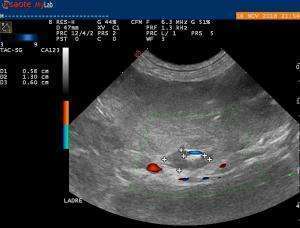– Middle aged MN DSH presented for abdominal ultrasound due to uncontrolled diabetes.
-US: severe pancreatitis with pancreatic abscess/parapancreatic cyst of approx 3cmx5cm. Severe peritoneal inflammatory reaction around pancreas and kidneys and adrenals. Adrenals mildly enlarged (0.6cm approx).Left one presents area of calcification (can be normal in cats).
-Abscess drained for culture and no bacteria/infectious agents seen on cytology (drainage was after 36h on synulox). Awaiting culture results.
– Middle aged MN DSH presented for abdominal ultrasound due to uncontrolled diabetes.
-US: severe pancreatitis with pancreatic abscess/parapancreatic cyst of approx 3cmx5cm. Severe peritoneal inflammatory reaction around pancreas and kidneys and adrenals. Adrenals mildly enlarged (0.6cm approx).Left one presents area of calcification (can be normal in cats).
-Abscess drained for culture and no bacteria/infectious agents seen on cytology (drainage was after 36h on synulox). Awaiting culture results.
-What differentials would you include for adrenal findings?, how common is it to get plump adrenals (adrenalitis?) due to either surrounding peritonitis or chronic systemic infectious/inflammatory process? (if possible at all).
-Finally…referring vet is worried about HAC as underlying cause. I think at this stage HAC diagnosis may be difficult without correcting the pancreatic abscess. Would that be a fair assumption? to postpone HAC tests for after stabilization of pancreatitis?

Comments
These mineralized adrenals i
These mineralized adrenals i see a lot in older cats especially with chronic disease but odd for middle aged. Are you sure about the age? They are symmetric and slightly plump which makes sense during sickness and stress. If USG is low and clinical parameters for cushings are present then I would work up for PDH (rare but does happen in cats) and surely get a BP but my gut says these are incidental and that abscess its the major issue.
TThanks. I agree with that.
TThanks. I agree with that. Now, just some fine tunning…ill double check the age. The culture was negative to aerobes and anaerobes.
In this case I thought the adrenals were not the problem but the last time I assumed that in a cat with these type of plump adrenals (without the calcification even) it ended up having insulinoma metastasis in the adrenal…so now I am a bit more wary than before. In any case, my question is how do you list the differentials for these type of adrenals in your report? Or let me repgrase it, what do you list? If you don’t mind…as in what would you write in the report?
In terms of testing for PDH…wouldnt the diabetes and the uti and the stress interfere in diagnosis? I expect isostenuria in a diabetic cat with uti?(I’ll double check the uti, too)
Thanks so much for your answer. As usual always helpful.
So then, cat is 12 years old.
So then, cat is 12 years old. His urine didn’t show a positive bacteria in culture. My colleague reports not really PUPD. For what is worth.
Testing Cushing’s disease in
Testing Cushing’s disease in cat with pancreatitis will give skewed results. Are there clinical signs of Cushing’s – obesity, thin friable skin, poor hair coat? Another possiblity for uncontrolled diabetes would be acromegaly – can look at measuring insulin growth factor. Acromegaly has been diagnosed in around 30% of diabetic cats.
Thanks. Yes the cat is
Thanks. Yes the cat is overweight and his skin was thin that’s why my colleague suspected Cushing. It’s been a few days now and the patient has not had another abscess drainage and I’m not sure how he is doing. I’ll update the forum when I know the outcome. Thanks so much for the input so far. Very appreciated